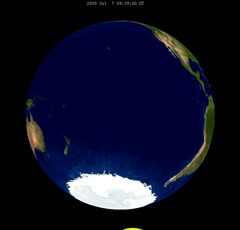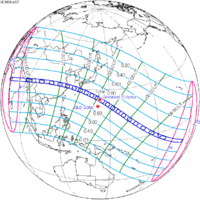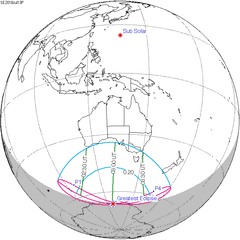July 2009 lunar eclipse
| Penumbral eclipse | |||||||||
 The Moon grazed the southern penumbral shadow of the Earth. | |||||||||
| Date | July 7, 2009 | ||||||||
|---|---|---|---|---|---|---|---|---|---|
| Gamma | −1.4915 | ||||||||
| Magnitude | −0.9116 | ||||||||
| Saros cycle | 110 (71 of 72) | ||||||||
| Penumbral | 121 minutes, 29 seconds | ||||||||
| |||||||||
A penumbral lunar eclipse occurred at the Moon’s ascending node of orbit on Tuesday, July 7, 2009,[1] with an umbral magnitude of −0.9116. A lunar eclipse occurs when the Moon moves into the Earth's shadow, causing the Moon to be darkened. A penumbral lunar eclipse occurs when part or all of the Moon's near side passes into the Earth's penumbra. Unlike a solar eclipse, which can only be viewed from a relatively small area of the world, a lunar eclipse may be viewed from anywhere on the night side of Earth. Occurring only about 8 hours before apogee (on July 7, 2009, at 17:40 UTC), the Moon's apparent diameter was smaller.[2] This eclipse entered only the southernmost tip of the penumbral shadow and thus was predicted to be very difficult to observe visually.[3]
This eclipse was the second of four lunar eclipses in 2009, with the others occurring on February 9 (penumbral), August 6 (penumbral), and December 31 (partial).
Visibility
[edit]The eclipse was completely visible over eastern Australia and western North and South America, seen rising over western Australia and setting over eastern North and South America.[4]

|
 Hourly motion shown right to left |
 The Moon's hourly motion across the Earth's shadow in the constellation of Sagittarius. |
 Visibility map | ||
Eclipse details
[edit]Shown below is a table displaying details about this particular solar eclipse. It describes various parameters pertaining to this eclipse.[5]
| Parameter | Value |
|---|---|
| Penumbral Magnitude | 0.15783 |
| Umbral Magnitude | −0.91159 |
| Gamma | −1.49158 |
| Sun Right Ascension | 07h06m54.1s |
| Sun Declination | +22°32'55.2" |
| Sun Semi-Diameter | 15'43.9" |
| Sun Equatorial Horizontal Parallax | 08.7" |
| Moon Right Ascension | 19h08m08.1s |
| Moon Declination | -23°51'38.0" |
| Moon Semi-Diameter | 14'42.6" |
| Moon Equatorial Horizontal Parallax | 0°53'59.3" |
| ΔT | 65.9 s |
Eclipse season
[edit]This eclipse is part of an eclipse season, a period, roughly every six months, when eclipses occur. Only two (or occasionally three) eclipse seasons occur each year, and each season lasts about 35 days and repeats just short of six months (173 days) later; thus two full eclipse seasons always occur each year. Either two or three eclipses happen each eclipse season. In the sequence below, each eclipse is separated by a fortnight. The first and last eclipse in this sequence is separated by one synodic month.[6][7][8]
| July 7 Ascending node (full moon) |
July 22 Descending node (new moon) |
August 6 Ascending node (full moon) |
|---|---|---|
 |
 |

|
| Penumbral lunar eclipse Lunar Saros 110 |
Total solar eclipse Solar Saros 136 |
Penumbral lunar eclipse Lunar Saros 148 |
Related eclipses
[edit]Eclipses in 2009
[edit]- An annular solar eclipse on January 26.
- A penumbral lunar eclipse on February 9.
- A penumbral lunar eclipse on July 7.
- A total solar eclipse on July 22.
- A penumbral lunar eclipse on August 6.
- A partial lunar eclipse on December 31.
Metonic
[edit]- Followed by: Lunar eclipse of April 25, 2013
Tzolkinex
[edit]- Preceded by: Lunar eclipse of May 26, 2002
- Followed by: Lunar eclipse of August 18, 2016
Half-Saros
[edit]- Preceded by: Solar eclipse of July 1, 2000
- Followed by: Solar eclipse of July 13, 2018
Tritos
[edit]- Preceded by: Lunar eclipse of August 8, 1998
- Followed by: Lunar eclipse of June 5, 2020
Lunar Saros 110
[edit]- Preceded by: Lunar eclipse of June 27, 1991
- Followed by: Lunar eclipse of July 18, 2027
Inex
[edit]- Preceded by: Lunar eclipse of July 27, 1980
- Followed by: Lunar eclipse of June 17, 2038
Triad
[edit]- Followed by: Lunar eclipse of May 7, 2096
Lunar eclipses of 2009–2013
[edit]This eclipse is one of five lunar eclipses in a short-lived series. The lunar year series repeats after 12 lunations or 354 days (Shifting back about 10 days in sequential years). Because of the date shift, the Earth's shadow will be about 11 degrees west in sequential events.
| Lunar eclipse series sets from 2009–2013 | ||||||||
|---|---|---|---|---|---|---|---|---|
| Ascending node | Descending node | |||||||
| Saros # Photo |
Date Viewing |
Type chart |
Gamma | Saros # Photo |
Date Viewing |
Type chart |
Gamma | |
| 110 | 2009 Jul 07
|
penumbral
|
−1.4916 | 115
|
2009 Dec 31
|
partial
|
0.9766 | |
120
|
2010 Jun 26
|
partial
|
−0.7091 | 125
|
2010 Dec 21
|
total
|
0.3214 | |
130
|
2011 Jun 15
|
total
|
0.0897 | 135
|
2011 Dec 10
|
total
|
−0.3882 | |
140
|
2012 Jun 04
|
partial
|
0.8248 | 145 | 2012 Nov 28
|
penumbral
|
−1.0869 | |
| 150 | 2013 May 25
|
penumbral
|
1.5351 | |||||
| Last set | 2009 Aug 06 | Last set | 2009 Feb 9 | |||||
| Next set | 2013 Apr 25 | Next set | 2013 Oct 18 | |||||
Saros 110
[edit]This eclipse is a member of Saros series 110. The previous event occurred on 27 June 1991. The next event is on 18 July 2027 which will end the series.
Half-Saros cycle
[edit]A lunar eclipse will be preceded and followed by solar eclipses by 9 years and 5.5 days (a half saros).[9] This lunar eclipse is related to two partial solar eclipses of Solar Saros 117.
| July 1, 2000 | July 13, 2018 |
|---|---|

|

|
See also
[edit]- List of lunar eclipses and List of 21st-century lunar eclipses
- File:2009-07-07 Lunar Eclipse Sketch.gif Chart
Notes
[edit]- ^ "July 6–7, 2009 Penumbral Lunar Eclipse". timeanddate. Retrieved November 15, 2024.
- ^ "Moon Distances for London, United Kingdom, England". timeanddate. Retrieved November 15, 2024.
- ^ Sky&Telescope: "The moon skims through too little of the penumbra to be noticed even by the most intent observer." Archived February 2, 2009, at archive.today
- ^ "Penumbral Lunar Eclipse of 2009 Jul 07" (PDF). NASA. Retrieved November 15, 2024.
- ^ "Penumbral Lunar Eclipse of 2009 Jul 07". EclipseWise.com. Retrieved November 15, 2024.
- ^ (AFP) – 6 days ago. "AFP: Solar eclipse sparks tourism fever in China". Archived from the original on July 27, 2009. Retrieved July 22, 2009.
{{cite web}}: CS1 maint: numeric names: authors list (link) - ^ Wang, Hongjiang (July 22, 2009). "Scientists: China the best place to observe longest solar eclipse in 2,000 years_English_Xinhua". News.xinhuanet.com. Archived from the original on May 21, 2009. Retrieved July 22, 2009.
- ^ "Indian students on solar eclipse 'odyssey' to China – Yahoo! India News". In.news.yahoo.com. Archived from the original on July 29, 2009. Retrieved July 22, 2009.
- ^ Mathematical Astronomy Morsels, Jean Meeus, p.110, Chapter 18, The half-saros
External links
[edit]- 2009 Jul 07 chart: Eclipse Predictions by Fred Espenak, NASA/GSFC
- Penumbral Eclipse of the Moon: 2009 July 07 Archived July 1, 2010, at the Wayback Machine
- Eclipses During 2009 [1]
- http://www.shadowandsubstance.com/



